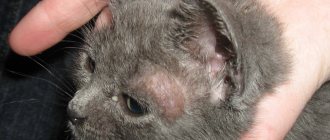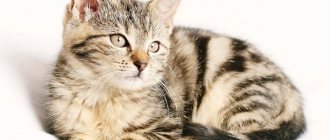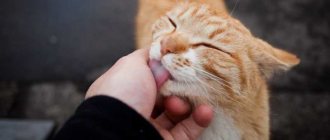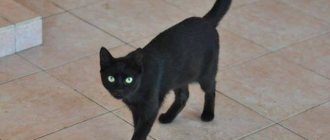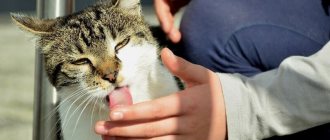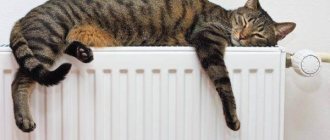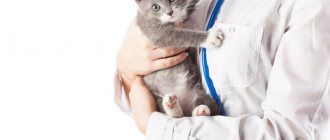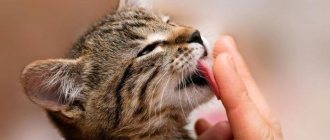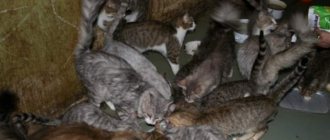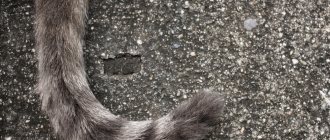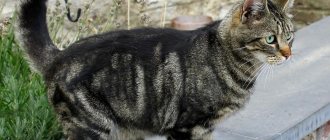Why did the cat fluff its tail?
If a cat has fluffed up its tail, this can mean a lot.
A fluffy tail can be a sign of anger, fear, excitement or playfulness. But in any case, it indicates that the cat is experiencing strong emotions. The cat's tail is an amazing part of this animal's anatomy. You could say that it is a kind of anatomical masterpiece that performs a lot of different functions, ranging from balancing to a communication tool. The different position of the tail can tell the owner a lot about what mood his pet is in at the moment. And if the owner is interested in achieving the greatest intimacy with his pet, he needs to learn to understand the cat's tail.
Surely every cat owner has seen how their animal fluffs its tail to such an extent that it becomes like a brush. But why does the cat do this? The purpose of this action is to demonstrate its defensive position, which the cat takes when it feels threatened or if it is simply in a highly excited state. By fluffing its tail as much as possible, the cat strives to create the impression of a larger body than it actually is. Along with the tail, as a rule, the fur on the back of the neck also fluffs up. It is especially noticeable how the fur along the spine stands on end. With such actions, the cat seeks to show its enemy that it is very large and scary. And this often bears fruit.
However, it is worth noting that a fluffy tail does not necessarily mean that the cat is scared and takes a defensive position. If you observe cats more closely, you will notice that they quite often fluff their tails during games, when they fight with each other or chase a toy. In this case, there is no longer any talk of fear; the cat simply imitates a hunting model of behavior. Therefore, it is logical to assume that a cat can accept a fluffed and reared tail while hunting. Kittens do this especially often when they play various chasing games. Probably, a fluffy tail indicates excitement and an excited state of mind of the cat. In fact, at any moment when this animal experiences strong emotions, such as excitement, anger or fear, it can fluff its tail. The most common causes of a fluffy tail are excitement and fear.
Click “Like” and receive only the best posts on Facebook ↓
Source
Symptoms and diagnosis
If the owner suspects damage to the tail of his pet, it is necessary to immediately find out how serious the problem is and whether it is really a pearl. Knowing the main symptoms of a tail fracture, the owner will be able to respond adequately:
The organ at the site of possible injury will be bent. Depending on the severity of the damage, the depth of the bend will depend. If the pearl is indeed present, then a kink in the tail will be evident. The tissue around the affected area will be swollen. Presence of a bleeding wound. Any touch to the injured part will cause severe pain to the animal. Increased temperature of the damaged organ and the whole body.
After an injury, the owner should keep an eye on the cat, because a fracture of the tail is not always accompanied by a clear bend. It may appear smooth, but the fact that the injury is serious will be indicated by the pet’s behavior and various signs.
The animal may have involuntary urination, and sometimes there is uncontrolled excretion of feces. But such symptoms do not always indicate that the cat has a broken tail. This is possible if the spine is damaged.
If it is confirmed that the pet has a tail fracture, he needs urgent hospitalization at the veterinary clinic. Doctors will use x-rays to diagnose and prescribe the necessary treatment. In difficult cases, if an animal’s tail injury has led to paralysis, an MRI, ultrasound, and blood test may be prescribed. Also, if the clinic has such a service, electromyography is prescribed. This is a method by which they determine how well nerve impulses travel through the muscles and peripheral nerves, that is, they determine the severity of the injury.
shutterstock
Cats take various manipulations calmly, but severe pain and the presence of strangers can provoke panic in the animal. It will be difficult to carry out a full diagnosis. In such cases, the veterinarian may decide that general anesthesia is necessary. In this way, he will make his work easier and the condition of the cat, who is experiencing torment.
Why do cats fluff their tails?
Cats may not speak our language, but they have their own ways of explaining what they feel. Cat body language provides insight into our pets' emotions and reactions, and the tail is one of the best means of communication.
Most owners have seen how a cat fluffs up its tail - it becomes several times larger than usual! This reaction can occur for various reasons. If you pay attention to your pet's other behavior, you can determine how he feels.
Physical problems
Veterinarians focus on the health status of the pet if its behavior is a symptom of disease. The reason for chasing your own tail can be pain, itching, burning caused by:
- parasitic diseases – worms, fleas, ticks;
- inflammation of the paraanal glands;
- anal herbs;
- constipation;
- skin diseases;
- allergies to food;
- tail injuries - fracture, bites of other animals, compression, torn ligaments;
- mental disorders, for example, the consequences of brain injuries and infections.
It is necessary to pay attention to such behavior in a timely manner. Also watch the video why a cat chases its tail:. Also watch the video why a cat chases its tail:
Also watch the video why a cat chases its tail:
The cat is scared
Often a fluffy tail is a sign that the animal is very scared. This is an instinctive reaction - cats try to look larger in order to discourage the one they are afraid of from approaching. Their bushy tail will point either up or down. The cat may also arch its back and flatten its ears. A high-pitched, scary growl or hiss is also typical in such situations. In this case, the owners should eliminate the source of the animal’s fear and let it calm down in a quiet place.
Anger and readiness to attack
Less fearful cats may skip the "scared cat stage" and go straight into attack mode. They tuck their tails between their legs for the same reason - to look big and intimidating - but in this case it means a direct warning. Cats may look cute and cuddly at first glance, but their claws, teeth and natural predatory instincts can be dangerous to the enemy who threatens them.
An angry cat will hiss at its opponent and lay its ears flat against its head. The fur on his back can also stand on end. Most cats prefer distant aggression to a full-on attack, but if their intimidation methods don't work, they will show that they are not afraid to use their claws.
Features of the structure of a cat's tail
In most cats, the tail makes up approximately 10% of the total number of vertebrae in the spine. A more specific figure is 19–23 vertebrae. The unique maneuverability of the tail is provided by the musculoskeletal structure, which also includes ligaments and tendons. In an adult, the tail is on average:
- in a cat - 25 cm in length;
- for a cat - 28 cm.
The tail is an extension of the spine
The spine of felines has a “logical” conclusion - the tail. This part of the animal’s body has a certain special status, since the sacral region has fused vertebrae, representing a single bone, and the tail originates from there. Its external characteristics are somewhat reminiscent of a whip.
A cat's tail makes up the caudal section of its spine.
The cat's tail is conventionally divided into three fragments:
- root;
- stem;
- tip.
The vertebrae are wider in diameter at the base and narrow towards the tip. They are shorter in length. The first 5–8 vertebrae resemble an arch. The last vertebrae do not have a spinal canal. The end of the tail is crowned by a vertebra of small length and diameter. It is distinguished by asymmetry or sharpness. It may also be rudimentary (underdeveloped).
Between the vertebrae there are intervertebral discs, they are very plastic, so the cat's tail is very mobile.
The tail is very strong thanks to the ligaments. High mobility of the tail is ensured by three long tail muscles and a large number of short ones.
The cat's tail is equipped with muscles that ensure its high mobility.
Video: why you shouldn’t pull a cat’s tail
Cat tail length
Cats - owners of long tails - have different lengths of this part of the body. The measurement is taken from the extreme point of the sacrum to the extreme point of the last vertebra. The length ranges from 20–28 cm to 40 cm, which depends not only on the individual characteristics of the animal, but also on its breed. For example, Persian cats have a shorter average tail length than Orientals, while Maine Coons have a slightly longer tail.
Maine Coon is a breed of long-tailed cat
About tailless cats
There are cat breeds that have a very short tail, and there are those that don’t have one at all. There are only two breeds of completely tailless cats: Manx and Cymric. These breeds are not allowed to breed other cats. The reason for the lack of a tail was genetics.
Cymrik - a breed of tailless cats
In addition to tailed and tailless cats, there are cat breeds that have short tails. These include the bobtail breed. The tails of these animals are limited to 5–7 vertebrae, have strong pubescence, resembling a pompom in appearance.
Japanese Bobtails have a very short tail that looks like a pom-pom.
Cat tail thickness
The tail is divided into two types based on the thickness of the vertebral stem: thin and thick. The assessment is based on the massiveness of the animal and depends on the strength of the bones. The average value of this parameter can rarely be found. Often when describing the tail, the shape is indicated instead of the thickness, for example:
- tail, thick at the base;
- tail tapered to the tip;
- thin tail.
Photo gallery: cats of different breeds and their tails
Other anatomical features of tails, genetic anomalies
Some cats have abnormal tail shapes. They can be represented:
- crease. It represents the elevation of one vertebra above another. It turns out to be a kind of step-up effect. These vertebrae may be the same in length, or they may be different. The edges are necessarily rounded;
- kink. Step down effect;
- bending Elevation of one or more vertebrae above an imaginary straight line. Often vertebrae with this anomaly have a wedge shape;
- knot formation. Several vertebrae fuse into one.
Playfulness
It may be hard for many cat owners to believe, but a fluffy tail is not always a bad thing. This reaction is possible when the cat is feeling especially happy and playful. This is more typical for kittens, but adult cats can fluff their tails when they are having fun. At the same time, it is not difficult to notice the difference between a happy pet and a stressed cat: erect ears indicate that the animal is interested in what is happening; his mustache will be directed forward. Cats also love to wag their bushy tails and pounce like predators when playing.
Source
The meaning of body movements
The cat is a graceful creature with developed muscles and amazing flexibility. It is easy for her to give her body any desired position and make a variety of movements. The ability to recognize these signs helps you understand exactly what your pet wants to tell you and what emotions he is experiencing. A cat can:
- to mark time;
- rub against legs;
- lie on your back, opening your stomach;
- bend and straighten paws;
- arch your back;
- curl up into a ball.
Quite often, cat owners notice how she begins to move her front paws, mark time, as if she is “kneading dough.” This movement indicates that the pet feels pleasant emotions and is comfortable. This habit has remained from an early age, when the kitten kneads its mother’s belly so that milk flows into the nipples. The owner can consider marking time a declaration of love.
Everyone understands that if a cat rubs against its legs, it communicates a feeling of affection and expresses gratitude. But such movements are not only a manifestation of positive emotions. The pet must leave its scent so that all other animals immediately understand that this is its owner.
With this gesture, the cat can ask the owner for food or say that it needs attention and affection.
In the language of animals, lying on your back means submission. If a cat takes this position, opens its tummy, it confesses its love and says that it completely trusts you. The owner may consider such a gesture as an expensive compliment.
A confident, calm, peaceful pet has straightened legs. If a dangerous situation arises, the cat “crouches.” Bent hind and front legs indicate that she does not want to fight, but if necessary, she will provide adequate protection. The animal can sit on its hind legs and stretch out in a column, like a gopher. The cat takes this position when it is overcome by curiosity and must understand what is happening.
It is easy to understand that an arched back is a challenge, a preparation for the upcoming battle. This gesture can be seen before cats fight. At the same time, the animals' ears flatten, their eyes open wide, and the hair on their tail and back stands on end. Cats can also arch their backs during play, thus demonstrating their readiness to attack.
A peaceful, calm pet curls up comfortably into a ball and rests. He is comfortable, he does not feel any danger. A relaxed position on the side with outstretched legs also speaks of calmness.
Learning cat language will help you communicate comfortably with your pet and know everything about its desires and emotions.
Authors of the articles: Belanta Clinic team
Why did the cat fluff its tail?
If a cat has fluffed up its tail, this can mean a lot. A fluffy tail can be a sign of anger, fear, excitement or playfulness. But in any case, it indicates that the cat is experiencing strong emotions.
The cat's tail is an amazing part of this animal's anatomy. You could say that it is a kind of anatomical masterpiece that performs a lot of different functions, ranging from balancing to a communication tool. The different position of the tail can tell the owner a lot about what mood his pet is in at the moment.
Eyes
A person's eyes are the mirror of the soul. For a cat, things are a little different, but they can still tell you something. Wide, rounded pupils of a cat indicate severe fear, and much less often - surprise. If a cat you are unfamiliar with reacts to you in this way, it needs time to get used to the presence of a stranger, and it is better to leave it alone for a while. If, on the contrary, the pupils became very narrow, she was up to something. Most likely, she is angry and perhaps seeks revenge on the offender.
In the cat world, a direct, open gaze does not mean at all the same as for a person. A point-blank look is a competition for primacy, finding out “who is in charge here” - this is how rival cats behave. If the cat is peaceful and does not pretend to be a leader with the animal or person, it looks away, turns away and closes its eyes. That is why a pet that has become too naughty needs to be “reconsidered” in order to be put in its place.
What makes a cat fluff its tail?
If a cat has fluffed up its tail, this can mean a lot. A fluffy tail can be a sign of anger, fear, excitement or playfulness. But in any case, it indicates that the cat is experiencing strong emotions.
The cat's tail is an amazing part of this animal's anatomy. You could say that it is a kind of anatomical masterpiece that performs a lot of different functions, ranging from balancing to a communication tool. The different position of the tail can tell the owner a lot about what mood his pet is in at the moment. And if the owner is interested in achieving the greatest intimacy with his pet, he needs to learn to understand the cat's tail.
Surely every cat owner has seen how their animal fluffs its tail to such an extent that it becomes like a brush. But why does the cat do this? The purpose of this action is to demonstrate its defensive position, which the cat takes when it feels threatened or if it is simply in a highly excited state. By fluffing its tail as much as possible, the cat strives to create the impression of a larger body than it actually is. Along with the tail, as a rule, the fur on the back of the neck also fluffs up. It is especially noticeable how the fur along the spine stands on end. With such actions, the cat seeks to show its enemy that it is very large and scary. And this often bears fruit.
However, it is worth noting that a fluffy tail does not necessarily mean that the cat is scared and takes a defensive position. If you observe cats more closely, you will notice that they quite often fluff their tails during games, when they fight with each other or chase a toy. In this case, there is no longer any talk of fear; the cat simply imitates a hunting model of behavior. Therefore, it is logical to assume that a cat can accept a fluffed and reared tail while hunting. Kittens do this especially often when they play various chasing games. Probably, a fluffy tail indicates excitement and an excited state of mind of the cat. In fact, at any moment when this animal experiences strong emotions, such as excitement, anger or fear, it can fluff its tail. The most common causes of a fluffy tail are excitement and fear.
Click “Like” and receive only the best posts on Facebook ↓
How cats communicate using their tails
It is not always possible to understand from the face how to determine the mood of the animal and figure out what the cat wants. And it is the cat’s tail that will tell you about all the thoughts and emotions of the pet. Let's look at specific examples of why and how a cat twitches its tail:
- The four-legged pet smoothly swings its tail horizontally in different directions. Cat experts indicate this gesture as the fact that she cannot immediately make a choice between her desires. When the decision is made, the animal will calm down and stop twitching;
- if a cat lifts its tail and puts it vertically, it tells you that the pet’s thoughts are very interested in something;
- a slight twitch indicates strong affection and love for you;
- if the cat’s fifth limb is down, it means that she is bored;
- the tail is up, but the back is arched and the ears are pressed back - the cat cannot decide whether to attack or defend. He is very scared;
- the tail is in a curved arc position and the cat arches its back - it senses danger and is ready to defend itself. In this state, do not hit her and try to calm her down;
- a tail raised up (vertically) indicates that the animal is in a great mood and is ready for games and communication;
- a loosely drooping tail tells that the pet is in a calm mood, but is not inclined to communicate;
- a measured and rather strong horizontal waving of the tail indicates dissatisfaction and irritation;
- a wary animal's tail is lowered and ruffled;
- only the tip of the tail moves slightly - at the moment the pet is in an excellent mood and is happy with everything that is happening around him;
- the cat’s tail trembles and moves horizontally in different directions faster and faster - the hunt is in full swing and an attack on the prey will occur in the coming seconds;
- a vertically extended, quivering tail denotes a playful mood. It’s worth considering here that if the movements become faster and sharper, the cat beats its tail and may start meowing - the animal is getting too excited and it’s time to stop it. This is especially true when playing with small children - the danger of scratches and bites from a cat is too great;
- a tail wrapped in a ring around the body speaks of an excellent mood and trust in the surrounding world;
- the tail is raised halfway - the pet is confused and cannot determine its attitude towards a person or animal - to understand whether it is a friend or an enemy;
- fluffy tail and fur along the spine - the cat is furious;
- a vertically raised tail may mean that the cat is marking territory;
- sharp waving or tapping indicates stress and possibly pain;
- biting the tail signals the presence of parasites;
- in cold weather, cats wrap their tail in a ring around themselves, thereby reducing heat transfer;
- a vertically raised tail with a relaxed tip indicates joyful excitement;
- sits or lies with the fifth limb calmly extended - the cat is resting;
- in a sitting position, with paws tucked and tail wrapped - the animal is relaxed, but waiting for some action;
- a slight twitching of the whole body along with the tail means happiness and calmness of the pet. You can observe this when stroking it, scratching its ears or back. Will also be expressed in loud purring and squinting of the eyes;
- a leisurely and rhythmic twitching of the tail vertically indicates interest in something. The cat is relaxed, does not feel danger and is concentrated on the object of its attention. It is also expressed in the fact that the animal walks around the object of its interest and sniffs it;
- the desire to attack can be expressed in walking the fifth limb from side to side. If this occurs when playing with inanimate objects, then there is no need to worry. As soon as the cat gets tired of this activity, it will move away from it and forget about it quite quickly. At least until the next surge in gaming activity.
Cats move their fifth limb almost constantly. There are many explanations for this fact.
When communicating, you just need to pay attention to your pet’s mood. When there is mutual understanding between the owner and the pet, when they can understand and feel each other, then there will be practically no problems in communication
Just listen to what your cat is telling you. Indeed, contrary to popular belief, tail twitching can also mean great love and devotion towards you.
What makes a cat fluff its tail?
What makes a cat fluff its tail?
You and I, dear readers, know that cats are extraordinary creatures. At least those who are crazy about these animals are sure of this. But even the most ardent cat haters admit that they are incredibly delicate creatures. The palette of their feelings, and, accordingly, their body language is an order of magnitude richer compared to the same dogs. Cat owners need to understand dozens of nuances to understand what signals their pets send. Let's take the well-known cat's tail as an example! Do you think everything is simple with him?
Of course, even a novice cat lover knows that a cat's tail shaking as if in a fever indicates incredible irritation of the animal. It's all true! What if the tail also fluffed up at the same time? Then what should we do? By the way, all this looks quite comical from the outside! It’s even more interesting to watch the hairless sphinxes, which make fantastic movements, as if copying their furry counterparts, but the problem is that they have nothing to fluff!
So what makes a cat fluff its tail?
Anger or the highest degree of irritation. Here we will not open America to anyone. If a cat shakes its tail, it means it is unhappy. Most often, scenes with shaking and “fluffing” of the tail can be found during cat “showdowns”: this means that the conflict threatens to escalate into a heated phase.
Hair loss in cats: physiological causes
Thinning of a cat's coat and “scattering” of hairs everywhere is not always a sign of illness, although it is quite unpleasant for the owners. Wool on sofas, clothes, in plates - almost every furry owner has encountered this. The reasons for this are often trivial:
Shedding
Seasonal shedding (in spring and autumn) in cats living in apartments often drags on for 2-3 months. This is due to a violation of biorhythms and temperature conditions in the room. With extensive hair loss, the pet looks quite healthy: clean eyes, a moist nose, good appetite and normal activity.
Old age
Older cats rarely have thick fur. They often have bald spots, and long hairs remain in clumps. There is nothing dangerous in this, but it is worth remembering the increased risk of developing various diseases in older cats.
Stress
It is generally accepted that cats adapt well to any situation. Few people know that fluffies have a very delicate nervous system. Any stressful situation - the departure of the owner, a long stay in the house of guests who “didn’t like” the pet, etc. - can provoke excessive hair loss, up to complete baldness. The cat may refuse its usual food, its activity decreases, and its general health worsens.
Pregnancy
Hormonal changes and lack of vitamins in pregnant and lactating cats are manifested by baldness around the nipples. During this period, vitamin supplements and a balanced diet are especially important, which will help maintain the health of both the “mother” and her kittens.
Poor nutrition
Hair loss in cats is often caused by a lack of vitamin. group B. This often affects pets that eat human food or cheap food. Every cat lover should know: sausage, fried fish and food seasoned with salt and spices are absolutely not suitable for cats. Such a diet can not only provoke hair loss, but also cause severe gastrointestinal diseases and allergies.
What does a cat's tail say?
Everyone knows that a cat’s mood can be determined by the position of its tail, which is a kind of indicator of the animal’s emotional state.
When at rest, the tail hangs freely or wraps around the cat's body. When greeting the owner, she lifts her tail straight up and at the same time walks towards you. When communicating with relatives, your pet will also raise its tail up in a quick movement, but at the same time arch its back and purr in greeting.
In order to show respect, trust and deference to the owner, cats usually turn their backs to him and raise their tail up.
Head and mustache
The head and whiskers can also tell a lot about a cat.
Head raised
The meaning of this gesture depends on the circumstances. If a cat is happy, it will raise its head, showing curiosity and trust. Usually this gesture is accompanied by pricked ears. On the other hand, if a cat has been cornered by another cat, it will lift its head, showing dominance, and press its ears to its head, protecting them.
Head down
This gesture signifies submission and humility. It can manifest itself in the event of an attack by another cat. In a calmer situation, a lowered head can symbolize drowsiness, boredom, or tranquility.
Cat whiskers
Whiskers can serve as an indicator of a cat's mood. If the whiskers point forward, the cat is relaxed, happy and curious. If the antennae are directed back, it means that the cat is taking a defensive position, or it is about to attack.
Reasons for the reaction
The animal uses various body movements to communicate with the outside world. When a person begins to stroke him and the kitten puts his butt up, purrs, crawls closer to the owner and looks with narrowed eyes - this is the highest degree of pleasure for the pet from stroking. In this way he shows that he likes the affection, he asks to continue. Often, the cat raises his tail - this is his natural property to invite him to sniff the anus. This is how animals show attention to each other when the individuals are pleasant to each other and not annoying. If you pet a cat, and he spins around, meows, presses himself to the floor, lifts his tail and wags it, the animal does not like the affection and is irritated.
The cat sticks out its butt when stroking it when it indicates a high degree of emotional delight and pleasure.
Why does a cat chew the tip of its tail?
Content
So, there may be several reasons why your cat may be chewing the tip of its tail, and they may be related to various areas: dermatology, neurology, orthopedics and even oncology.
Dermatological reasons
If we consider the dermatological side of the issue, then you should note whether you have noticed that your pet has recently begun to lick itself more and more often or scratch itself in places other than the tip of its tail. Frequent grooming in cats is one of the manifestations of itching. The cause may be parasites, most often fleas, whose bites occur on the thinnest areas of the skin, including the tail. Itching can also be caused by food hypersensitivity reactions and atopic dermatitis, but the manifestation of these pathologies only by restlessness in the area of the tip of the tail is uncharacteristic. Another possible cause could be vasculitis, an immune reaction aimed at blood vessels that become inflamed and destroyed, leading to discomfort for the animal.
An injury, bite, or burn is possible, so carefully examine the problem area from the anus yourself, maybe the tick is sitting there and causing discomfort.
The problem may also lie in inflammation of the paraanal sinuses (these are paired glands located on both sides of the anus, which are normally emptied with feces).
Neurological causes
Let's consider a possible neurological cause - obsessive-compulsive disorder (OCD). OCD is a syndrome characterized by the presence of obsessive thoughts (obsessions), to which a person or animal responds with certain actions (compulsions). This pathology is an exclusion diagnosis if there is no other explanation for the animal’s behavior based on the results of examinations (consultation with a dermatologist, exclusion of orthopedic problems, possibly an MRI of the brain), as well as with a positive response solely to sedatives and behavioral therapy. Usually the cause of this condition is severe stress.
External factors and emotions
Cats use their tail quite freely. A free position, when the tail is lowered to the ground with a slightly curved tip, is the norm for an animal at rest. However, tucking the tail, holding it close to the belly, or not raising the tail during the day are clear violations.
Aggression – before attacking or feeling the need to defend themselves, cats tuck their tails or lash their sides with it. This is a natural reaction as the animal protects itself with its tail, covering its belly. By whipping itself on the sides, the pet encourages itself, in other words, it gathers its strength and thoughts.
Severe fear is also the reason why a cat presses its tail. Let’s immediately make a reservation that an absolutely passive reaction is unusual for cats, but is possible for a number of reasons:
Protection of offspring, when the cat understands that it must protect children with its own body. That is, the pet cannot move away from the nest to fight back the aggressor, but understands that it will have to fight.
Repeated beatings, humiliation - inhumane treatment will make any animal afraid. It is unusual for cats to have a passive defensive reaction unless they are locked in a narrow space and are not prepared for the most dire consequences.
Severe stress - an apartment cat lost on the street will move exclusively with its tail between its legs.
Some cat breeds are characterized by emotionality. They actively use body language to express their feelings. Particularly active cats can get excited and attack the owner. This usually happens during the game. To avoid more serious problems, punishments and stress, a kitten’s playful-aggressive behavior must be stopped immediately, without concessions or compromises.
While playing with an active cat, you may not intentionally hurt your pet, or the four-legged cat may think that circumstances have taken a serious tone. The pet will not attack without warning; it will take the appropriate stance and hiss. At this moment, you need to stop any gaming activities, silently and quickly leave the room, closing the door behind you. A few minutes of complete peace and isolation will allow cats to relax a little. If this happens, think about what exactly went wrong during the game and what was the reason for the aggression.
Injury
If a cat's tail hangs, you need to remember what the animal did shortly before. Most often, this results from an injury received during an unsuccessful landing. Also, the tail could have broken from being severely pinched by a doorway.
You can check the fracture yourself. To do this, you should observe the animal. A curled tail in cats will hurt and cause discomfort.
If there is a fracture, the problem will have to be solved by simply waiting. The fracture can be fixed with a special bandage or plaster. In some cases, your veterinarian may prescribe an antibiotic and anti-inflammatory medication.
If an x-ray does not reveal a fracture, but the problem began after a fall, a specialist will diagnose a bruise. It will take time for a hanging tail to recover.
Genetic pathologies
Are there other causes of curvature of the tail in cats? Yes, and there are quite a lot of them. In particular, in the Burmese breed, a crooked tail is an extremely common pathology that is inherited. Sometimes a litter can contain more than 50% of these kittens. Of course, animals with such a defect are strongly recommended to be excluded from the reproduction process, but in reality this is not always possible. Owners of “crippled” pets can take comfort in the fact that the pathology does not in any way affect the health and quality of life of the cat.
It is much worse and more dangerous when the curvature of the tail is caused by some kind of neurological disorder. For example, pathology can develop after severe head injuries or diseases accompanied by damage to the nervous system. Finally, the tail can take on “extravagant” shapes after pinching, injuries to the back and specifically the spine. The fact is that with these pathologies there is a very high risk of pinched nerve bundles and damage to the spinal cord.
Why do animals have fluffy tails?
Actually, the answer to this question is quite simple. The tail is covered with wool to protect it from external factors. Long hairs of wool, covering it with a thick layer, perfectly protect against the cold, keeping it warm. And on hot days they prevent sun rays from reaching the skin.
For example, if a fox had a bald tail, it would cause a lot of problems in winter. Since the fox does not use holes and sleeps right in the snowdrifts, she would have to think about heating it all the time. Moreover, foxes often cover their faces with them while sleeping, protecting their muzzles from snow and wind.
Do not forget that the tail contains vertebrae, joints and soft tissues. In cold weather, wool protects them from frostbite and other negative consequences. In hot weather, it blocks the harmful effects of ultraviolet radiation. In fact, the hair on the tail is literally a protective layer. Often the covering on the tail matches the color and texture of the rest of the fur.
The tail of most animals is fluffy, since the fur acts as a protective layer. In cold weather, it warms the vertebrae and joints located inside, and the animals themselves do not mind using the tail as a blanket. On hot days, wool protects against the harmful effects of sunlight. Also, some animals deliberately spread their fur to appear larger when danger appears. And others use it as a broom, covering the tracks they leave in order to hide from predators and send them down the wrong path.
Sperm whale - description, habitat, food, enemies, life expectancy, photos and videos
Hyperfunction of the sebaceous glands
This pathology is called sebaceous tail. The owner of the animal notices that the cat's tail is covered with a dense layer of fat, which is difficult to remove. In some cases, you may notice dried blood at the root of the tail.
Causes
The main reason for the occurrence of a sebaceous tail is a malfunction of the sebaceous glands located at the base of the caudal process. The normal functioning of the paraanal glands helps the functioning of the rectum, and the act of defecation in the animal proceeds normally.
Other reasons are:
- infection of the paraanal glands;
- malfunctions of normal glands;
- increased keratin production;
- high levels of sex hormones;
- eating disorders;
- insufficient care of the animal.
When bacterial microflora enters the gland, the passage begins to narrow and the specific secretion contained in them accumulates, causing discomfort to the cat.
Increased production of a specific secretion leads to blockage of the sebaceous ducts, causing inflammatory processes in them. Such a neoplasm can fester, forming abscesses.
Symptoms of the disease
In cats with thick fur, the disease is much more difficult to detect than in short-haired breeds. Pathologies are discovered quite late, when it is already in an advanced stage.
The basic symptoms of the disease are:
- the appearance of fat on the root of the tail, which is difficult to wash off;
- on the skin in the area where the hairs emerge, inflamed tubercles with purulent crusts are observed;
- scratching and scars on the root of the tail;
- breaking off hair at the tip of the tail;
- “riding” an animal on a hard surface on its butt.
Treatment methods
Therapy for the disease is quite long. It is necessary to regularly bathe the cat with shampoo containing lactic acid, which promotes good washing of the fur. At the same time, the product does not dry out the skin, but helps to gently exfoliate dead cells. When diagnosing hormonal imbalances in an animal’s body, castration is recommended. This will normalize hormonal levels and stabilize the functioning of the sebaceous glands.
An important role is played by proper cat nutrition, rich in mineral and vitamin complexes. It is recommended to include special additives in the animal’s diet and adjust the diet.
Brain hemorrhage
Older felines, just like people, are susceptible to strokes. When a cerebral hemorrhage occurs, some of the brain cells, neurons, die due to poor circulation. There is also an ischemic form, when the vessel does not burst, but is clogged with a blood clot or cholesterol plaque. Both types of stroke often lead to paralysis of one or more limbs in the animal, depending on the severity of the case.
The tail may also remain motionless. By the way, castrated individuals are more often susceptible to this problem, which is facilitated by weight gain and low physical activity. The rehabilitation process takes time, and the animal is not always able to cope with the negative consequences of the disease.
(0 votes, average: 0 out of 5) Share with your friends!
Systemic treatment
Although the “greasy tail” in itself does not threaten the life and health of the pet, it is a reason to consult a veterinarian. It is necessary to identify the cause, depending on which treatment is prescribed:
- If the cat is intact, there is a high probability that the problem will disappear after castration.
- If the animal is of breeding value, but does not receive the highest points at the exhibition due to the poor quality of the coat and skin, hormonal drugs are used that temporarily suppress reproductive function (Suprelorin).
A dermatologist must be competent in issues of endocrinology. There are hormones that provoke excessive formation of sebum - these are not only sex hormones (androgens, progesterone), but also hormones of the adrenal cortex and adrenocorticotropic hormone of the pituitary gland. Estrogens suppress sebum production.
- Systemic diseases are excluded, especially those related to digestion and metabolism - for this it is useful to take a detailed biochemical blood test.
- The doctor analyzes the cat’s diet; some animals need diet correction. This includes the selection of low-fat feeds, the introduction of food additives that normalize the condition of the skin (contain B vitamins, zinc, sulfur, Omega-3 fatty acids). For obese animals, a weight loss plan is drawn up with mandatory weight monitoring twice a month.
For severe inflammation of the skin and deep comedones, the veterinarian may prescribe a course of antibiotics and anti-inflammatory hormonal drugs. But such measures are needed only when the problem is advanced; in general, the treatment of sebaceous tail comes down to regular local treatments.
Why do cats need tails?
Nature does not tolerate excesses; it implements every decision with some intent. And the seemingly simple and somewhat childish question “Why do cats need tails?” can throw anyone into a stupor.
The problem here is not so much the reasons why cats have tails - there are more than enough of them - but the fact that it is impossible to give an unambiguous answer to the question posed. But first things first.
For reference: the tail is a completely natural extension of the cat’s spine.
Vitamin deficiency as a cause of alopecia
Quite often, a pregnant cat becomes bald near the tail. In this case, we are talking about a lack of nutrients - vitamins and microelements. A cat bearing kittens needs a special diet, taking into account the changing needs of the body. Alopecia in pregnant animals should be treated by changing their diet. If the cat's diet consists of natural food, it should be supplemented with special fortified supplements. Dry food during pregnancy must be replaced with special products intended for pregnant cats. Such foods are distinguished by a large amount of vitamins and microelements that cover the body’s need for these substances.
You might be interested in: Why does a cat have bad breath: causes and treatment
Vitamin deficiency also affects small kittens and older animals. This problem occurs especially often in kittens taken from the street. Due to the lack of normal nutrition, the immunity of animals weakens, against which a number of diseases develop, including hair loss. In all cases, you can get rid of the symptom only by adjusting your diet.
You should consult your veterinarian about the need to administer special supplements to older animals (over 7 years old). The fact is that at this age, alopecia may be a consequence of systemic disorders that need to be identified and, if possible, corrected.
How to understand a cat's mood by its tail
Our brain is designed in such a way that it is good at reading emotions from facial expressions, but gives up when it comes to deciphering the behavior of an animal. People subconsciously attribute human emotions to the behavior of pets, but this is fundamentally wrong. However, there is a “translation” from cat language to human language.
The tail is held by a pipe
When a cat raises its tail vertically and holds it straight, this indicates the friendliness of its owner. By this action, the pet makes it clear that he is in a friendly mood and is ready to play and be cuddled.
This is usually how cats greet their owner, thereby expressing the feline equivalent of human joy at the sight of a friend. Sometimes this means that the cat is going to beg some tasty treat from the person or asks to pet itself.
Held at a 45 degree angle
If the tail is raised at an angle to the floor, this shows that the cat is hesitating. You need to be on your guard, because when she makes up her mind, she can reveal anything: scratch the new leather sofa, shit in her shoes, or ask to be caressed.
Tail raised and swaying
If the furry limb is raised and sways from side to side, then this is a signal that the cat is in a playful mood.
Important! Don't grab cats by the tail: they don't like it.
A child tortures a cat
In addition to causing them pain, such rash actions can lead to urinary incontinence, limb injuries, and in some cases even paralysis of the hind legs.
Raised up and twitching
This is a variation of expressing feelings using a vertically raised tail. In this way, the cat expresses sincere joy towards the object of its attention.
It can be either the owner or the guest who plays or pampers the pet with treats. Other pets love to enjoy small treats too. For example, dogs love to shake their tail.
Raised up with a curved tip
In this state, the cat needs no one to touch or bother it. Maybe she just wants to lie there and purr until she feels better.
Source
Treatment: first aid and correction of the situation
Bandaging the tail will be sufficient if there are no serious consequences after the injury. Therapeutic measures are determined by the degree and extent of damage to the caudal vertebrae and the location of the wound. If only the tip of the tail hangs without violating the integrity of the skin, most likely, serious manipulations will not be required. The cat needs complete rest, proper nutrition and bandaging. When the fracture is open, first of all you need to remove all the fragments, first stopping the bleeding. Manipulations are carried out under local anesthesia. After providing first aid, an operation is prescribed to restore the integrity of the vertebrae and treatment with antibiotics.
Recommendations from veterinarians for owners
Basic actions that are allowed by specialists to provide first aid to a pet:
- Treat and wash the wounded area with an alcohol-containing preparation. If the wound near the tail is small, treat it completely, and if it is large, treat only the edges. You can use Chlorhexidine or Betadine.
- Remove hair around the break by cutting with sharp, sterile scissors.
- If the animal remains calm, apply a bandage.
- Deliver the cat to the veterinary clinic.
Reduction and casting
After repositioning the parts of the organ, a plaster cast is applied to it. If a fracture occurs with displacement of the vertebrae, the veterinarian returns them to their place under local anesthesia, applies a splint and a tight plaster cast for 2-3 weeks. It is advisable to tie a special collar around the animal’s neck. If this is not done, the pet simply removes the bandage that was tied. After the specified period, a repeat x-ray is taken to determine whether immobilization has the desired effect and the tail is fused. In severe cases, the animal is left under observation in a hospital. The owners will be required to ensure complete rest and proper care. Cats are prescribed a diet, vitamins, and medications to speed up bone healing.
Amputation operations
This type of radical surgery is performed by a veterinarian for indications such as tail injuries with paralysis. As a rule, such a complication is typical if the cat’s tail is broken at the base in an open manner and the back is damaged. After amputation, it will take 2-3 weeks for rehabilitation. The same dangerous situation is considered to be when a cat has a crooked tail due to a fracture and at the same time the functioning of the bladder and intestines is disrupted. The phenomenon is accompanied by urinary and fecal incontinence. In this case, the tail is docked and body functions are restored.
The next indication is cases when necrosis is observed, that is, the damaged tail rots or has completely fallen off. Surgery is needed if the organ was accidentally torn off by dogs when the cat got into a fight with them. Amputation is considered a last resort, because the recovery of a cat after such an operation is long and difficult. This technique is also useful when the tail is broken in 2 places.
